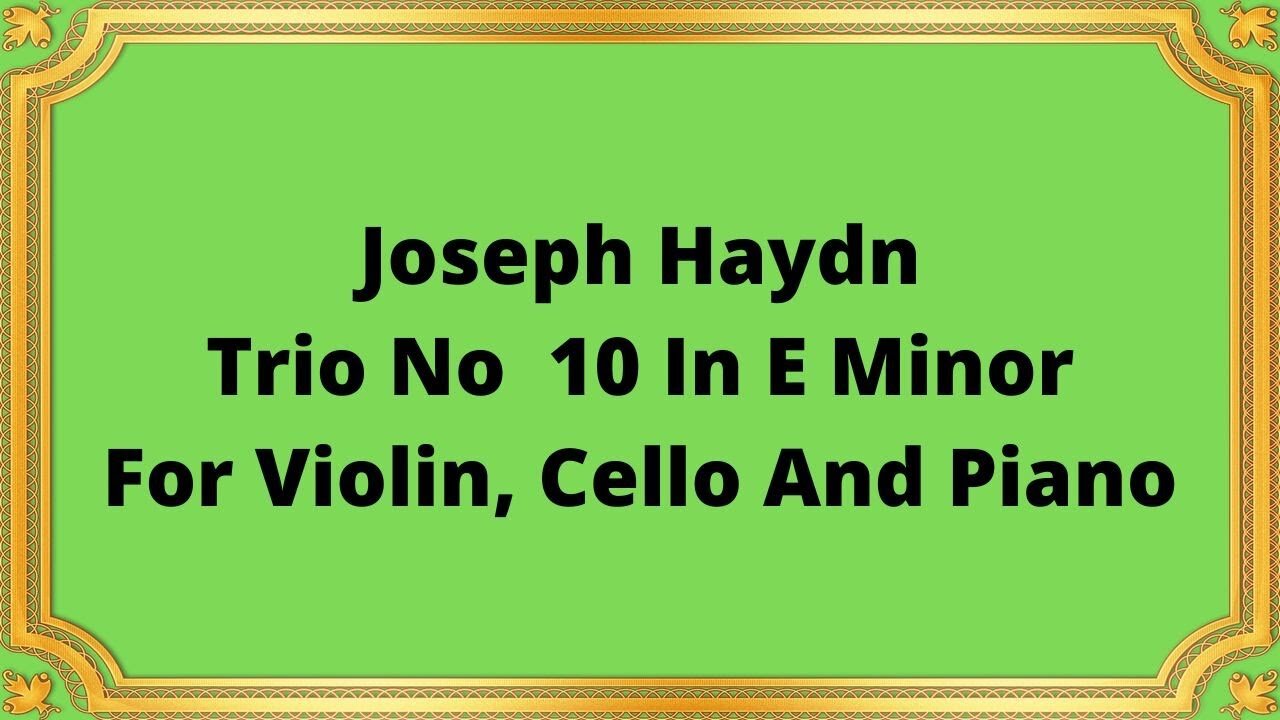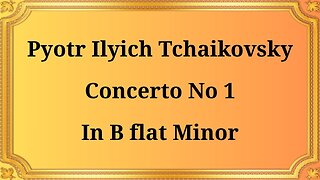Premium Only Content

Joseph Haydn Trio No 10 In E Minor For Violin, Cello And Piano
#classicalmusic #JosephHaydn #TrioNo10 #EMinor #Violin #Cello #Piano #MusicalComposition #HaydnTrio #ClassicalComposers #MusicHistory #ClassicalEnsemble #ChamberMusic #HaydnInfluence #HaydnLegacy #MusicPerformance #HaydnTrioNo10
Publication date 1955
JEAN FOURNIER, Vion
ANTONIO JANIGRO, celo
PAUL BADURA-SKODA, Piano
Joseph Haydn, one of the greatest composers of the Classical era, left an indelible mark on the world of music with his remarkable compositions. Among his vast repertoire, Joseph Haydn's Trio No. 10 in E Minor for Violin, Cello, and Piano stands as a testament to his genius.
Composed during the late 18th century, Haydn's Trio No. 10 in E Minor exemplifies the transition from the Baroque to the Classical era. This period witnessed a shift towards a more balanced and structured approach to music, characterized by clarity, elegance, and emotional depth. Haydn, often referred to as the "Father of the Symphony," played a crucial role in shaping this new musical landscape.
Haydn's Trio No. 10 in E Minor is a testament to his mastery of chamber music. It consists of four movements – Allegro moderato, Menuetto, Adagio, and Finale: Allegro. The opening Allegro moderato immediately draws the listener in with its passionate and expressive melodies. The Menuetto, a lively and rhythmic movement, evokes a sense of dance-like joy. The Adagio, a poignant and introspective movement, provides a moment of respite and contemplation. The Finale: Allegro concludes the piece with its energetic and spirited character, leaving a lasting impression.
This trio showcases Haydn's ability to create intricate and balanced musical dialogues between the violin, cello, and piano. Each instrument has its unique role, with the violin leading the melodic lines, the cello providing a rich and supportive bassline, and the piano adding depth, harmony, and occasional virtuosic passages. Haydn's skillful interplay between the instruments creates a harmonious and cohesive ensemble.
Haydn's Trio No. 10 in E Minor remains a testament to his lasting influence on the world of music. Its beauty, technical brilliance, and exquisite craftsmanship have ensured its place among the chamber music repertoire. This composition not only showcases Haydn's prowess as a composer but also provides a glimpse into the evolving musical styles of the Classical era.
The Trio No. 10 in E Minor has continued to captivate audiences and musicians alike, offering a rich and nuanced musical experience. Its emotional depth, structural integrity, and intricate musical dialogues make it a significant contribution to the chamber music genre. This composition stands as a testament to Haydn's enduring legacy and his impact on the development of classical music.
Conclusion:
Joseph Haydn's Trio No. 10 in E Minor for Violin, Cello, and Piano represents a pinnacle of musical brilliance in the Classical era. Its historical significance, profound musical characteristics, and enduring appeal make it a cherished composition in the chamber music repertoire. Through this composition, Haydn's genius is unveiled, leaving us in awe of his ability to create intricate musical tapestries. The Trio No. 10 in E Minor continues to inspire and enchant listeners, reminding us of the timeless beauty and power of classical music.
You have the opportunity to support the channel:
https://destream.net/live/RadSiarAl/donate
https://www.buymeacoffee.com/6355radsiaral
-
 31:06
31:06
Classical music_Music Inspiration
25 days agoPyotr Ilyich Tchaikovsky Piano Concerto No. 1 in B-flat minor
571 -
 LIVE
LIVE
Drew Hernandez
9 hours agoLGBTQ TERRORIST EXECUTES CATHOLIC KIDS IN MINNEAPOLIS
741 watching -
 2:17:08
2:17:08
FreshandFit
5 hours ago10 Top Red Pills About American Women
37K16 -
 2:10:26
2:10:26
Badlands Media
10 hours agoDevolution Power Hour Ep. 383
49.2K6 -
 3:17:28
3:17:28
TimcastIRL
5 hours agoTrans Shooter Targets Catholic Kids In Mass Shooting, Leftists Reject Prayers | Timcast IRL
210K54 -
 1:31:29
1:31:29
Brandon Gentile
1 day ago25 Year Wall Street INSIDER: $1M Bitcoin Soon Is Just The START
12K -
 LIVE
LIVE
SpartakusLIVE
6 hours ago#1 Birthday Boy Celebrates with MASSIVE and HUGE 4.8-Hour Stream
321 watching -
 55:54
55:54
Man in America
8 hours agoFrom Oil Barons to Pill Pushers: The Rockefeller War on Health w/ Jeff Adam
36.3K3 -
 3:02:18
3:02:18
Barry Cunningham
5 hours agoBREAKING NEWS: PRESIDENT TRUMP THIS INSANITY MUST END NOW!
82.9K153 -

StevieTLIVE
4 hours agoWednesday Warzone Solo HYPE #1 Mullet on Rumble
29.6K